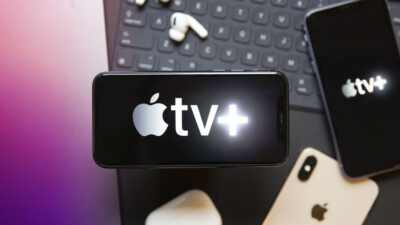It is time for the television industry in the United States to recognize the fact that companies like Google and other over-the-top video program providers are “at war” with over-the-air TV for viewers, advertisers, content and, ultimately, the entire television business, said Mark Aitken, Sinclair Broadcast Group VP of advanced engineering, Tuesday during a luncheon keynote at the 2014 Annual SMPTE Conference & Exhibition.
Speaking to hundreds of high-level TV, motion picture and video streaming engineers at a packed ballroom in the Loews Hollywood Hotel, Aitken said many in broadcast management at the station level are unaware of the threat because they have remained focused on the traditional measures of success — the station’s monthly, quarterly and annual sales financial performance.
“If our competitors believe they are engaged in a war, as an industry, if we are unaware we are at war, we are going to lose,” he said.
Television engineers have an important role to play, informing station management — which often came up through the sales or news departments — about the threats.
“We … as engineers are not taking a look at the surroundings in which we exist and taking the initiative to do the kinds of things and communicate … about where this all is going,” he said.
Station management is used to the broadcast business as usual and is unaware of the opportunities they will have to exploit revenue opportunities with other services.
Aitken pointed to the growing number of original programs available over the top and consumed on media tablets and smart TVs as a sign of developing cracks in the foundation of the TV business.
“The broadcast industry really has to unite, at least in a virtual sense, to look at what can we do to become a viable competitor in today’s marketplace.”
Advertising dollars have begun to leave the local TV market in favor of new media alternatives, he said. While the shift is small today, if left unchallenged “it will be a sorry state of affairs 10 years from now if we are still around.”
There needs to be recognition on the part of those creating technical standards for television about where the industry wishes to head from a business point of view, he said, pointing to the wireless industry an example of what can be accomplished.
For instance, the efforts of the wireless industry to offer broadcast-like services over their own networks with LTE Broadcast is the result of a standardization processes at the 3GPP standards body “that is looking out over the horizon” to where the wireless industry wants to be in five years and what is being deployed in the shorter term to support that goal.
Aitken called on the broadcast industry to think strategically in the same way. “We’ve got to evolve our standards in such a way that that kind of future is a possibility for us, too.”
He added that LTE Broadcast technology is being developed for use in foreign markets that one day could “end up eating our lunch with a capable LTE Broadcast mode, but thank goodness it is not here today. And I think we have opportunity to cut that off at the pass.”
Until as recently as last year, most broadcasters viewed their business in the same way they did in the mid 1990s when ATSC 1.0 was first deployed, he said.
Aitken also discussed the FCC’s incentive auction of broadcast spectrum and the appeal NAB and Sinclair are engaged in over the agency’s Report and Order laying out the details of the auction. How it addresses coverage, population served, having sufficient time to relocate before being required to relinquish a broadcast license and the process for redress after being assigned a new channel is part of the appeal, he said.
“We believe broadcasting, quite literally, is being marched to the cliff,” he said.
The law authorizing the FCC to conduct the auction also gives the agency authority to grant waivers to broadcasters of existing rules to make flexible use of their spectrum, he said. “They [the FCC] haven’t got a clue what it is,” he said. “They’ve asked us what we think it ought to be.”
Aitken said there is a growing number of broadcasters representing “hundreds and hundreds of stations” that are looking for a means to transition to the next-generation ATSC 3.0 standard “without displacing consumers” and do it in a way that “leaves our business uninterrupted … and an opportunity for growth in the future,” he said.
Flexible use can give broadcasters the means to make that happen, he said.
“The challenge that we have is one of thinking about what is it that we could do,” he said. Aitken called on those in the industry to encourage fresh thinking, allowing a range of ideas about where to take the business to surface and not shooting down any idea prematurely.
“We have reached the point where there is a dire need to do something different, and as an industry we have actually begun to turn that corner. I say that because there are numerous broadcasters that have a very similar opinion as to what the necessities are for the future.”
One of those areas of agreement, said Aitken, is that mobile has to be part of the future of television broadcasting. “There may be an argument about whether broadcasters need a standard of their own to support mobility, and we can have that discussion,” he said. “That is a business discussion.”
He cautioned that the “failure of” ATSC A/153-based mobile television is not an indication that viewers aren’t interest in content on the go, but more about broadcasters. “The failure of ATSC mobile was the failure on the part of all broadcasters embracing it as an opportunity. It was a problem coming to the table with a business discussion with rightsholders. It was a massive failure because an industry did not put its will behind it.
“That is a failure of leadership.”
Mobile video delivery is only one opportunity, he said. Offloading mobile data, not just pictures and sound, to broadcasters for distribution over the air is another. “I can say there is real money in the broadcast distribution of data,” he said.
The “Internet of Things” will require the mass distribution of uniform data to specialized devices, he said. “There is a huge opportunity … that today is being measured in trillions of dollars” for the Internet of Things, he said.
“Broadcasting is a platform that could uniquely provide that.”
To stay up to date on all things tech, follow Phil Kurz on TVNewsCheck’s Playout tech blog here. And follow him on Twitter: @TVplayout.

 Sinclair’s tech guru Mark Aitken urges engineers to make sure they keep their management aware of the threat from OTT video providers. “The broadcast industry really has to unite, at least in a virtual sense, to look at what can we do to become a viable competitor in today’s marketplace,” he says. Advertising dollars have begun to leave the local TV market in favor of new media alternatives, he said. While the shift is small today, if left unchallenged “it will be a sorry state of affairs 10 years from now if we are still around.”
Sinclair’s tech guru Mark Aitken urges engineers to make sure they keep their management aware of the threat from OTT video providers. “The broadcast industry really has to unite, at least in a virtual sense, to look at what can we do to become a viable competitor in today’s marketplace,” he says. Advertising dollars have begun to leave the local TV market in favor of new media alternatives, he said. While the shift is small today, if left unchallenged “it will be a sorry state of affairs 10 years from now if we are still around.”


















I am a consumer, not in the media industry. When will these legacy companies and industry learn they cannot hold back technology before it comes back to bite them and they are out of business. CHANGE is inevitable. Local TV is not needed anymore when you can pull in programming via satellite or internet. Local TV companies have you not learned anything from the music industry and all those companies who were the kings of their product and are now no more Sinclair you are a perfect example of one of these companies that needs to let go of the past, embrace technology and consumer choice, not bound by you.
Better get ready to fork over any discretionary income you may have had to the telcos as you will certainly be hit with expensive data plans and/or data overages–just for watching TV. Right now you can enjoy TV free with the simple technology of an antenna. But that will all change if the wireless providers have their way, aided and abetted by an Obama-run FCC.
Actually it is amazing how much money the Music Industry is rolling in right now as they have totally adjusted their business models – a model which is not selling CDs or Cassettes any longer. To say they are no more is totally incorrect.
your comment is a myth.
I too am a consumer and not in the media industry. But I look at it differently as we rely on antenna reception for most of our programming although we mix it with BluRay, DVD, online, etc. We don’t want to be paying high cable bills that would amount to over $1,000 a year. We have saved over $10,000 since we dropped payTV and have better things to do with the money other than pay for a lot of stuff we don’t want. The broadcast industry has done a very poor job of telling their story. Very few stations promote their multiple program services on the so-called sub-channels. They have a lot more to offer than most viewers know and they also offer a higher quality HDTV. Why not inform viewers (particularly important for those viewing on cable or satellite) how to pick up their signals with an antenna. Many grew up on cable and don’t know they can do it without cable. As more viewers cut the cord they need to know that OTA can be one part of what they replace payTV with. Antenna television which is better than ever thanks to digital can be part of the mix when viewers know about it. No reason to lose out if you lead viewers to your product rather than giving up and letting them get away.
HopeUMakeit – You are clueless.
Cassettes may be dead, but CDs still sell well, because they are many people who would rather buy their music that way, than through iTunes, Rhapsody, or any other Internet music service.
If people loved the antenna so much, the HH penetration would not be mired at 10-11 percent.
incorrect FlashFlood, CDs are dead as well. The owning music model of the Music Industry is dead, however they are rolling in money on the the new structure of the Industry.
Hope when there is a hurricane in Texas where armadillotx lives he can get his local warnings from Roku!
Hurricanes do not hit Amarillo, but infrequent Tornadoes and unexpected Snowfalls do.
Not sure how you determined that Armadillo is from Amarillo, but once the power goes out very few people are getting information from television – broadcast or wired. More likely it’s from radios powered by battery or perhaps even their mobile device.
Obviously Mark’s comments are the build up to the ONE Media/Sinclair rollout of their next-gen technology. If Google is at war with television broadcasters they long ago paid the rent on the battlefield with their generous contributions to Obama’s re-election and Obama is returning the favor by marching broadcasters (with the aid of his hand-picked henchman, Wheeler) to the edge of the cliff, as Mark so eloquently said. But I think Mark is being unfair when he blamed broadcasters for the failure of mobile DTV. It isn’t that we weren’t interested but we heard nothing but crickets from the smartphone and CE manufacturers. A dongle with a long antenna does not a mobile strategy make. Plus the technology itself, on the broadcast side, was an expensive Rube Goldberg contraption. What ONE Media/Sinclair are doing by testing a broadcast standard that is LTE-compatible is truly exciting. But if broadcasters are going to have any kind of future with mobile using this technology, they will need to retain their UHF spectrum, all of it. This will only work satisfactorily on the 600 MHz band.
Only RF channels 36-51 are in the 600 MHz band.
Yes, I’m aware of that. But even the next-gen technology works best in those channels–the very ones the government wants to hand over to the telephone companies like Verizon so that they can do their own LTE multicasting.
Yeah, and those channels will get knocked out in the auction.
My point, If the technology only works in the 600MHz range as you stated originally, then it will work for very few of the existing stations as it is now….not withstanding the upcoming repacking.
“Failure of leadership” is right. Broadcasting is not the newspaper industry, which was in total denial of disruption until it was almost too late. But broadcaster forays into new media, digital, new businesses, revenue streams, etc, are tepid at best. There is not total commitment and will to win (including resource)…more like “toes in the water” for the most part. TV Everywhere is a great example…failure to push relentlessly for effective implementations and marketing strategies has left it’s future in doubt, and left the door open for OTT alternatives.
Broadcasters are their own worst enemies. Like most people with a lucrative business model they feel that getting more from existing accounts is time better spent than pursuing new modes of gaining revenue. TV operators need to band together and do some of their own disruption. But that takes a certain lack of “bottom line” thinking, Disruptors spend a lot of money in many cases and wait a long tim for profits, but that is harder for mature industries to justify, even if it is obviously a defensive move that means long term survival. So Aitken is correct in many ways. However, the smug attitudes from the OTT post Millennial crowd and the cord cutting mavens who think they have the special formula is also BS. OTT is not the answer for so many content issues, and the broadband providers will soon be changing the “all you can eat” plans to more expensive data plans for everyone who thinks getting off of cable is the solution. Go get SEC or PAC 10 football from Roku and or Google, not going to happen in any horizon that I see.
I dont think streaming football is that far off. It’s the only sport at this point that you cant do (easily). Sports are the only thing keeping the current model going. I will never plan my nights around watching a TV sitcom on the time it airs live. I may watch it on the internet the next day or that week on my own time tho.
That far off? NFL is streaming on Verizon as well as DirecTV ST. While Sports is a large contributor of the current model, one only needs to look at ABC to see it is not the only thing keeping the current model alive.
Go Google the live streaming of last year;s Academy Awards. It is far from the BCS and the Super Bowl and it was not a great experience for the end user. Technology always solves problems long term, but the NFL and the NCAA do not grant carriage rights to disruptors that easily. Most of the issues surround rights to content, not tech problems.
Mobile, I appreciate your point of view, but everyone starts with “I would never….” You are not the profile of ever customer, everyone worries about OTT and prime time viewing declines. Local TV is more that 3 hours a night of crime dramas and sit-coms.
Ohh i realize I’m not everyone, probably not even the “average viewer” but I do represent a portion of the viewers. I streamed at least 20 World Cup games this summer, while it wasn’t perfect it was defiantly watchable. Now that baseball has gone 100% pay TV except for the world series I haven’t watched one full game this year. Times are changing, it’s just hard to see where it’s going.
where were all these engineers when the VHF broadcasors were forced to convert to digital and lose 30% of the DMA reach.?
Sinclair, in fairness, pushed to get as many of their stations into UHF as possible. At the time of the DTV transition, the only one they were unable to move was WLOS. (They’ve since bought a pile of additional stations, and a number of those are on VHF.)
There were MANY Corporate Engineers/Companies that went all out to move facilities to UHF from VHF, although I can think of several notables that touting their keeping of their VHF Frequencies until the second half of 2009 and early 2010.
The station we lost completely was one that moved from channel 2 analog to channel 7 digital. We didn’t completely lose any UHF channels or VHF channels that converted to UHF although with the loss of channels 52 to 69 there is more interference which causes frequent disruption of service on some channels due to nearby stations on the same channels. If UHF channels below channel 52 are lost due to the auction it will be a very severe blow to antenna viewing and broadcast television will disappear in the chaos created.
Since it’s apparent that the FCC’s goal seems to be is to eliminate broadcast television, they feel that their best chance IS the auction and repack. WE need to oppose the auction, we need to protect Broadcast Television!!!
If broadcasting is going to survive (flourish?) then it comes down to leadership…leadership by individuals and their companies that are committed, long-term, to OTA television. With so many broadcast companies being controlled by VC and equity partners, it’s hard to find broadcast companies controlled by broadcasters. Sinclair is (for all their other warts) one of those companies that is in broadcasting for the long term…hence the commitment, investment, and political efforts being made. They have been correct about everything they have predicted and I tend to believe that they see the future more clearly than most broadcasting companies. Mark is absolutely correct that we have to develop a long-term strategy and then execute it. And if you’re only in the broadcasting business to enjoy the 50% margins (milking the cow), without being willing to invest in the future (so that when you sell the cow to the slaughterhouse you get a better price) then do everyone a favor and exit.
Flourish, yes! We have argued that at the end of the FCC auction/repack process, we should be allowed to be a much more capable (and valuable) industry. That was the intent (supposedly) of the National Broadband Plan wasn’t it? That is our focus, not to simply remain ‘whole’…much, much more is possible.
To be fair to myself, the industries I positioned we are at war with are more than those focused on in the article. We clearly are a ‘most valued’ provider of content, and it is local (OTA) broadcast television originated content that is most watched as a percentage of total viewer engagement. I am arguing that we are limited in what we can ‘do’ as a function of limited technological capabilities. An overhaul is required in many areas of our technological underpinnings. Not just in the broadcast standard (although that is of primary importance), but many, many other business enabling tools that operate across the many platforms we should be engaged in/on. And, we need to operate together as an industry, locally competitive for sure, but collectively competitive against the many other distribution platforms…wireless carriers and broadband, satellite, cable, fiber, etc. And, yes, part of the message is ONE Media (www.onemediallc.com). A capable broadcast platform first, and the ability for that platform to inter-operate in the hybrid environment of the future (the ONE stands for Open Network Enabled). Just the start of what needs to happen, but certainly a healthy one…
Re Rocker’s comments on parallels to the Newspaper Industry… in 1982 as a newly minted MBA I worked on a project with 16 daily newspapers and CompuServe… Focus: would online classifieds destroy the daily newspaper? Conclusion: Probably, but not likely until the turn of the Century… but not because of Technology, but rather that the loss of Display revenue would undercut the funding of the newsroom… and thus the loss of the reader. Point being, I don’t think the critical issue facing local broadcast stations is really a tech issue, but rather a challenge to programming options and the resulting cash flow. Many years later as an old MBA (no wiser) I worked on ABC.com and Fox.com and the development of DAI… Dynamic Ad Insertion. What was interesting was the loss of local station ad inventory even within the C3 window because the stations no longer participated in Ad Splits in the world of VOD & OTT. The recent CBS OTT announcement is the biggest case in point, because even though the O&O’s are involved, the economic underpinnings of the Revenue model is dramatically shifting…. No Retrans in OTT and no station ad split in OTT. The one thing I have learned in those 32 years… pay attention to Revenue Disruption… the Tech guys will figure things out.. we the Bus Dev teams will always be the laggards! And this time it won’t take 32 years.